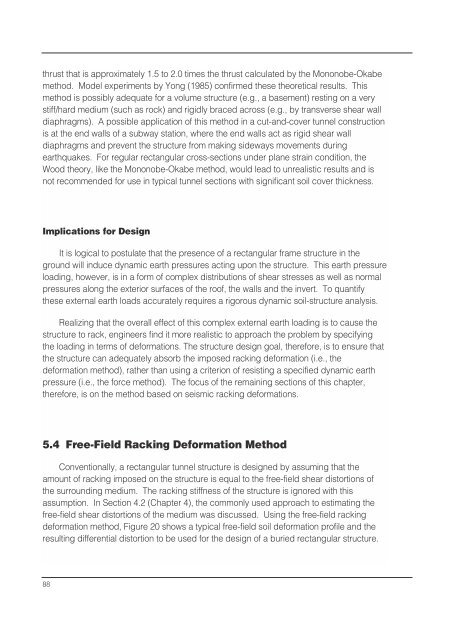Seismic Design of Tunnels - Parsons Brinckerhoff
Seismic Design of Tunnels - Parsons Brinckerhoff
Seismic Design of Tunnels - Parsons Brinckerhoff
You also want an ePaper? Increase the reach of your titles
YUMPU automatically turns print PDFs into web optimized ePapers that Google loves.
thrust that is approximately 1.5 to 2.0 times the thrust calculated by the Mononobe-Okabe<br />
method. Model experiments by Yong (1985) confirmed these theoretical results. This<br />
method is possibly adequate for a volume structure (e.g., a basement) resting on a very<br />
stiff/hard medium (such as rock) and rigidly braced across (e.g., by transverse shear wall<br />
diaphragms). A possible application <strong>of</strong> this method in a cut-and-cover tunnel construction<br />
is at the end walls <strong>of</strong> a subway station, where the end walls act as rigid shear wall<br />
diaphragms and prevent the structure from making sideways movements during<br />
earthquakes. For regular rectangular cross-sections under plane strain condition, the<br />
Wood theory, like the Mononobe-Okabe method, would lead to unrealistic results and is<br />
not recommended for use in typical tunnel sections with significant soil cover thickness.<br />
Implications for <strong>Design</strong><br />
It is logical to postulate that the presence <strong>of</strong> a rectangular frame structure in the<br />
ground will induce dynamic earth pressures acting upon the structure. This earth pressure<br />
loading, however, is in a form <strong>of</strong> complex distributions <strong>of</strong> shear stresses as well as normal<br />
pressures along the exterior surfaces <strong>of</strong> the ro<strong>of</strong>, the walls and the invert. To quantify<br />
these external earth loads accurately requires a rigorous dynamic soil-structure analysis.<br />
Realizing that the overall effect <strong>of</strong> this complex external earth loading is to cause the<br />
structure to rack, engineers find it more realistic to approach the problem by specifying<br />
the loading in terms <strong>of</strong> deformations. The structure design goal, therefore, is to ensure that<br />
the structure can adequately absorb the imposed racking deformation (i.e., the<br />
deformation method), rather than using a criterion <strong>of</strong> resisting a specified dynamic earth<br />
pressure (i.e., the force method). The focus <strong>of</strong> the remaining sections <strong>of</strong> this chapter,<br />
therefore, is on the method based on seismic racking deformations.<br />
5.4 Free-Field Racking Deformation Method<br />
Conventionally, a rectangular tunnel structure is designed by assuming that the<br />
amount <strong>of</strong> racking imposed on the structure is equal to the free-field shear distortions <strong>of</strong><br />
the surrounding medium. The racking stiffness <strong>of</strong> the structure is ignored with this<br />
assumption. In Section 4.2 (Chapter 4), the commonly used approach to estimating the<br />
free-field shear distortions <strong>of</strong> the medium was discussed. Using the free-field racking<br />
deformation method, Figure 20 shows a typical free-field soil deformation pr<strong>of</strong>ile and the<br />
resulting differential distortion to be used for the design <strong>of</strong> a buried rectangular structure.<br />
88
















